Kabocha squash is best when simmered to enhance its natural sweetness and nutty flavor. This is the most typical way it is eaten in Japan, especially because it’s so easy. The naturally sweet pumpkin is cooked in a savoury-sweet sauce to enhance the flavour even more and make the pumpkin velvety and tender. The result is a simple yet incredibly delicious side dish that goes well with any meal.
What is a Kabocha Squash?
“Kabocha” is a Japanese variety of winter squash similar to butternut squash or acorn squash. It’s most often called Kabocha squash or Japanese pumpkin. It has a hard knobbly dark green skin with uneven white stripes outside and bright orange flesh. When cooked, the pumpkin is firm and tender with a delicious sweet flavour comparable to sweet potato. It’s a common vegetable used in Japanese cuisine for many dishes like this simmered kabocha squash.
What does it Taste Like?
Kabocha tastes like a mix between pumpkin, sweet potato, and chestnuts. When simmered in the sweet soy sauce mixture, the pumpkin absorbs all the delicious sauce becoming even more infused with a savoury sweet flavour. It makes eating vegetables easy, especially for children.
Where to Buy Kabocha Squash?
For anyone in the US, kabocha squash can be found at Trader Joe’s, Walmart, and possibly other supermarkets. In Australia, grocery stores used to stock them from New Zealand but they are rare. I have also found it at the farmer’s market so no matter where you are, you can always check your local markets. The best time to find kabocha is during late summer to early fall when it’s in its true season, although you can find it year-round.
How to Pick a Good One?
The freshness does not always guarantee the deliciousness of this squash. Conversely, because the starch changes into sugar, an aged Kabocha will be sweet and have “hoku hoku” texture, meaning it’s steamy and tender but not soggy . Check the following points:
- Choose the one which has a stem base that is completely dry and looks like cork.
- The skin is shiny dark green and feels hard.
- Choose the one that feels heavy when held in your hand
How to Cut a Kabocha Squash?
The Kabocha pumpkin is very hard so it’s important to be very careful when cutting it. Use a sharp knife and cut the stem first making sure it is down on a flat surface (step by step photos 1- 4). After removing the seeds and pulp (step by step photo 5), it can be microwaved for 2 minutes making it softer and easier to cut. Slice the pumpkin into thick chunks/wedges so it’s ready to be simmered.
3 Tips for Making Simmered Kabocha Perfectly
- The art of simmering is important for this Kabocha squash recipe. I will give you three tips to keep its shape while it’s simmering. Simmering the Kabocha squash is fairly simple and it’s easy to cook. But the problem that often happens is that the kabocha squash loses its shape while being simmered. Follow these three tips to avoid this happening.
- Lay the skin side face down to the pot without leaving any gaps and without overlapping (prepare a suitable size pot) (step by step photo 9)
- Round off every corner of the kabocha chunk pieces (step by step photo 6)
- Cook with minimum liquid and use “Otoshibuta” (a drop lid) (step by step photos 15 and 16)
Japanese Cooking Secret : Otoshibuta
What is Otoshibuta?
Otoshibuta is an indispensable lid used in Japanese cooking which is a little smaller than the pot in its diameter. Traditionally, otoshibuta is made out of wood, but nowadays you can get steel and silicone otoshibuta as well.
Why Otoshibuta ?
- Otoshibuta holds the ingredients and prevents the ingredients from falling apart.
- It cooks ingredients evenly because the liquid underneath the Otoshibuta will be circulated.
- It forces the seasoning to penetrate well through the ingredients.
I don’t Have an Otoshibuta
No problem. You can substitute with parchment paper, baking sheets, or aluminium foil. See the below photo to make your own.
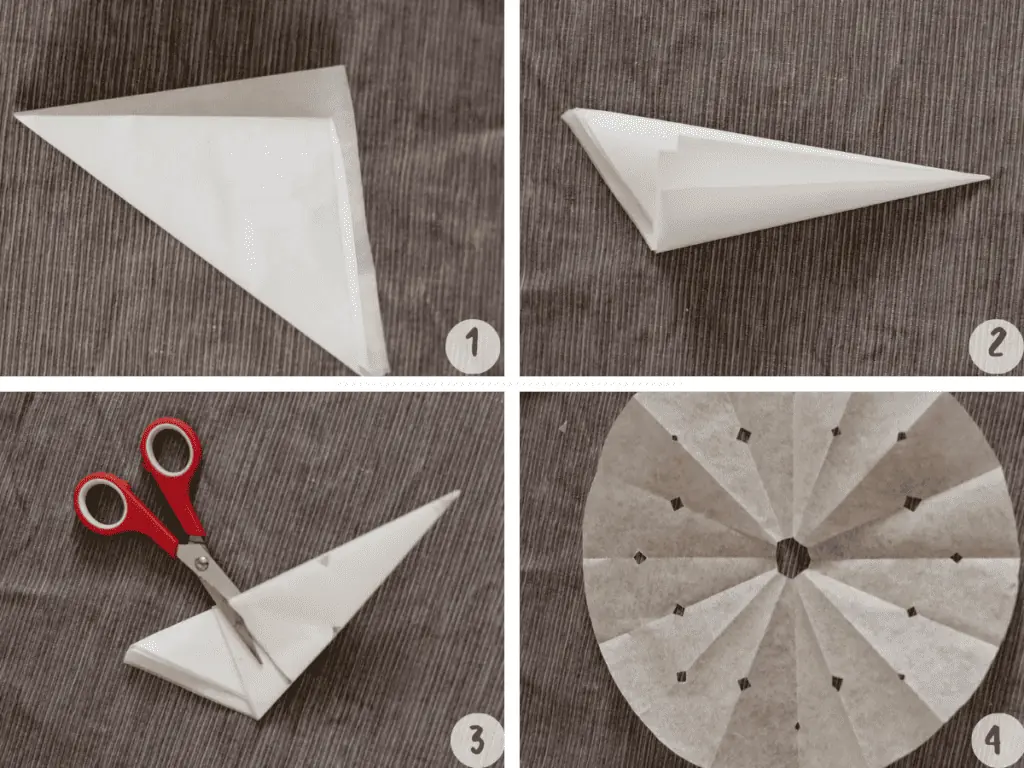
Other Japanese dishes that use the Kabocha Squash
This sweet savory dish isn’t all that you can do with Kabocha squash. This tasty pumpkin is good when simmered, roasted, pureed, mashed and deep-fried. You can try it as a roast by seasoning it with olive oil and a sprinkle of salt and pepper and tossing it in the oven or add it to curries, soups, and stews. It can even be used in desserts like muffins.
- Pureed – Kabocha pumpkin soup, Kabocha pumpkin bread
- Mashed – Kabocha salad
- Deep-fried – Tempura, Kushikatsu
Stay connected
Here are my instructions for simmered kabocha squash and if you liked it, please rate it and leave a comment or any questions below.
If you like the recipe please rate the recipe and leave comments below. Also don’t forget to follow me on Youtube, Pinterest, Facebook, Twitter and Instagram. This way you keep up to date with all the latest happenings on Chopstick Chronicles. Don’t forget to Sign up for a weekly newsletter so you never miss out on new authentic delicious Japanese recipes! Sign up form is on the right-hand sidebar.
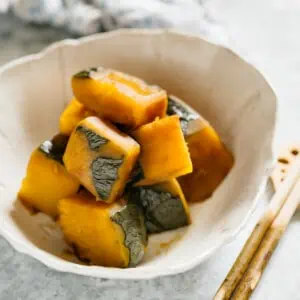
Simmered Kabocha Squash
Ingredients
- 1/2 Kabocha squash pumpkin *1
- 2/3 cup water
- 1 tbs sugar *2
- 1 tbs sake *3
- 1 1/2 tbs soy sauce
- 1/2 tbs mirin *4
Instructions
- Peel and seed the pumpkin then cut it into even sized chunks. *5
- Round off each corner of pumpkin cuts. *6
- Lay the cut pumpkin skin side down without leaving any gaps and without overlapping.
- Add water and bring to boil then turn the heat down to medium heat. Cook about 20 minutes or until the kabocha becomes soft.
- Add sugar, sake, and mirin and bring them to boil over medium heat.
- Once it has boiled, turn the heat down to low, and add soy sauce. Put a drop-lid (Otoshibuta) on to the Kabocha pieces directly and simmer for about 10 minutes or until the pumpkin is cooked. *7
- Garnish with chopped ginger. (optional)
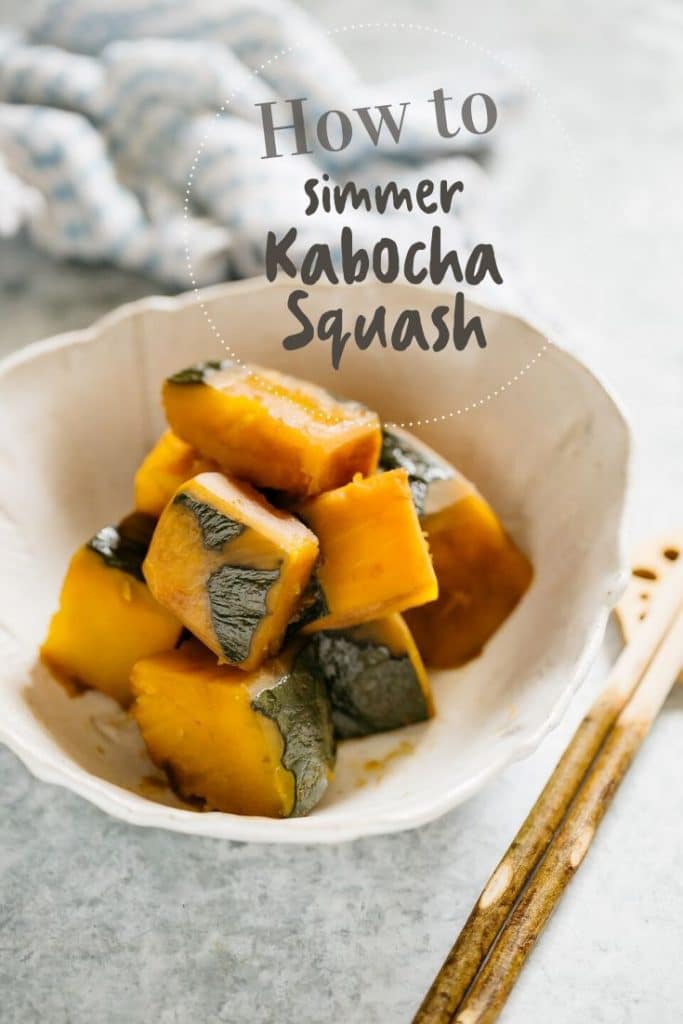
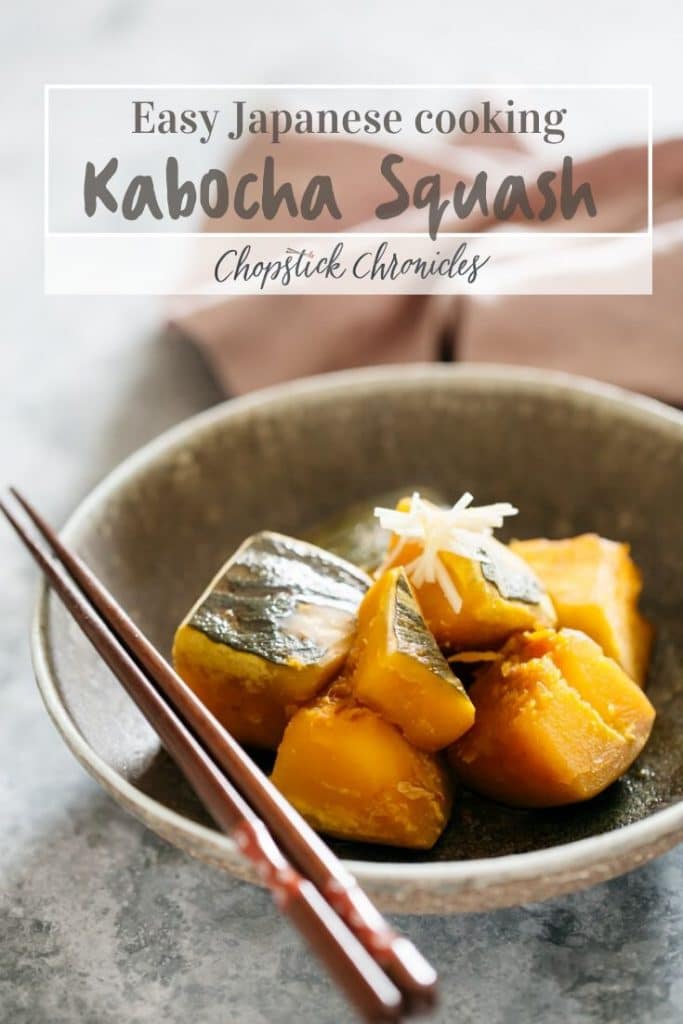
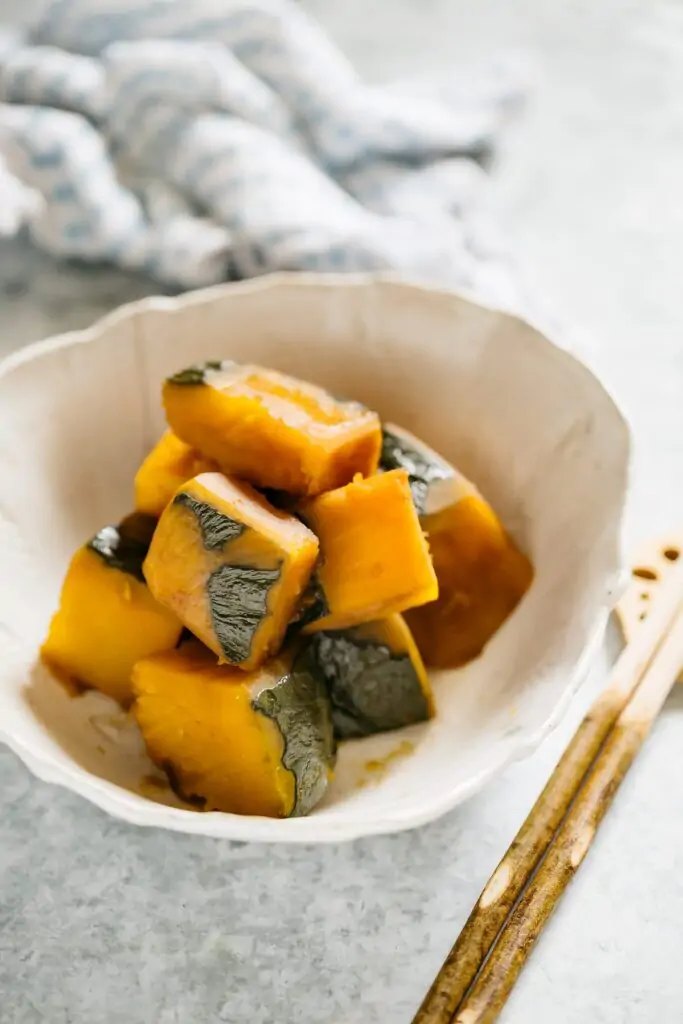
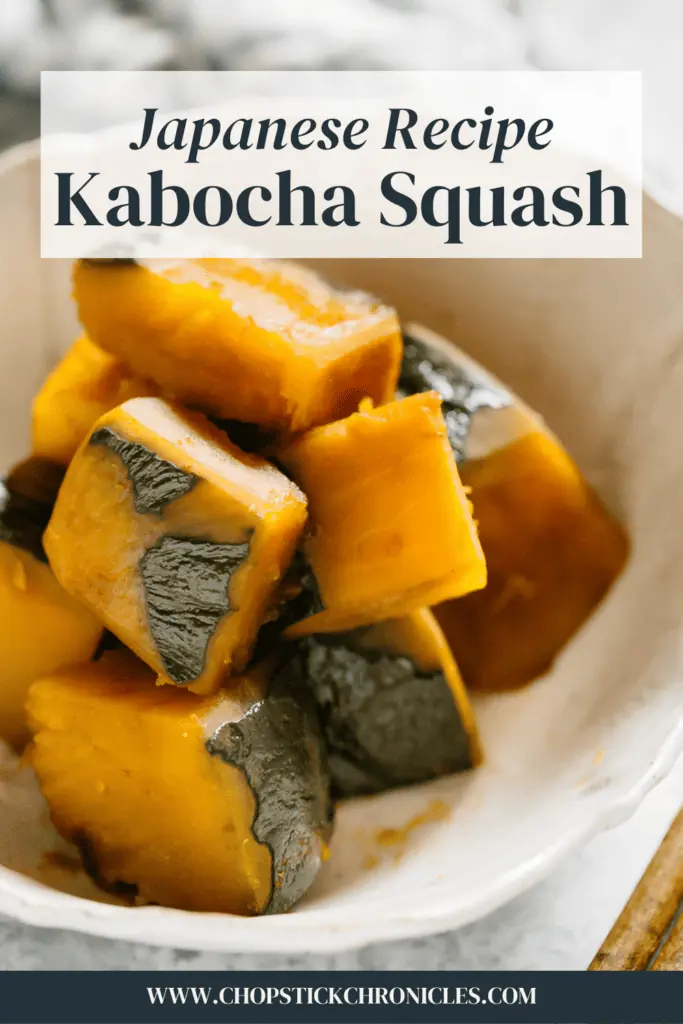
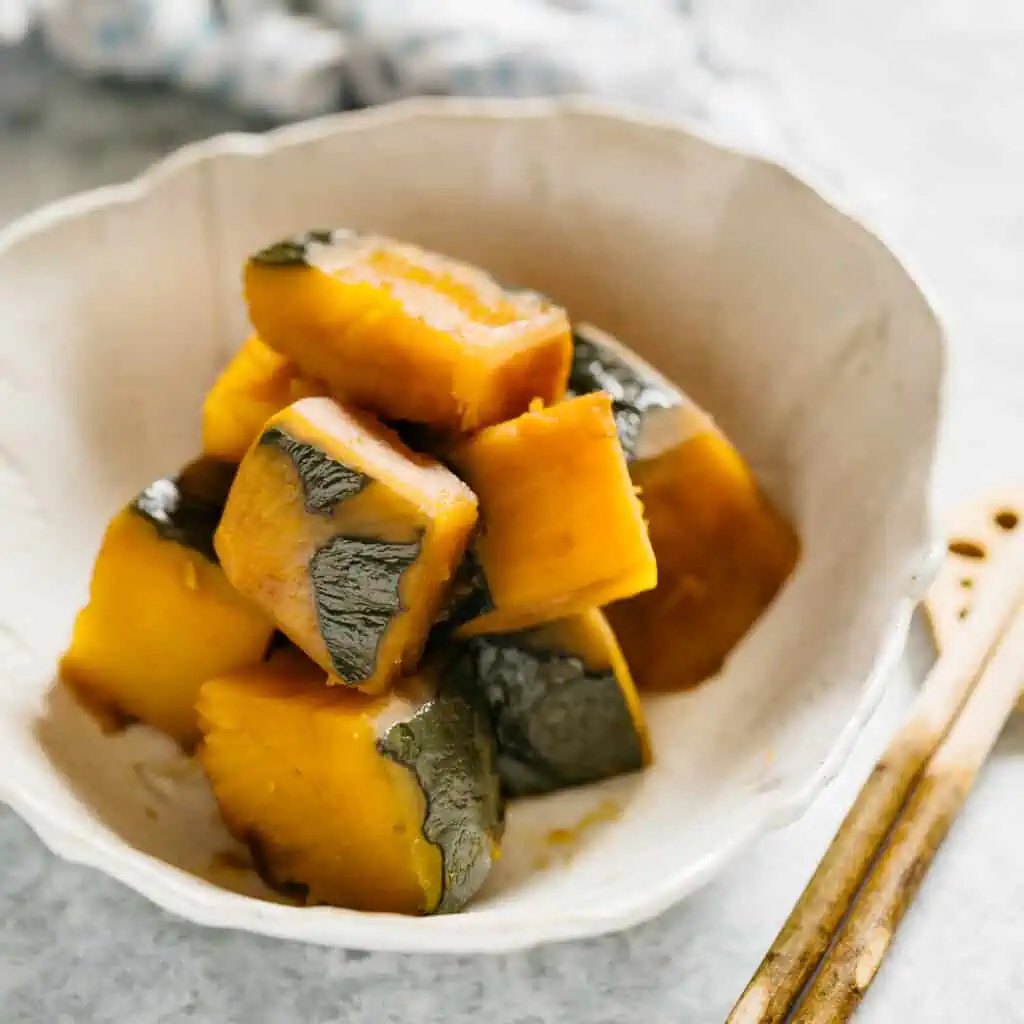
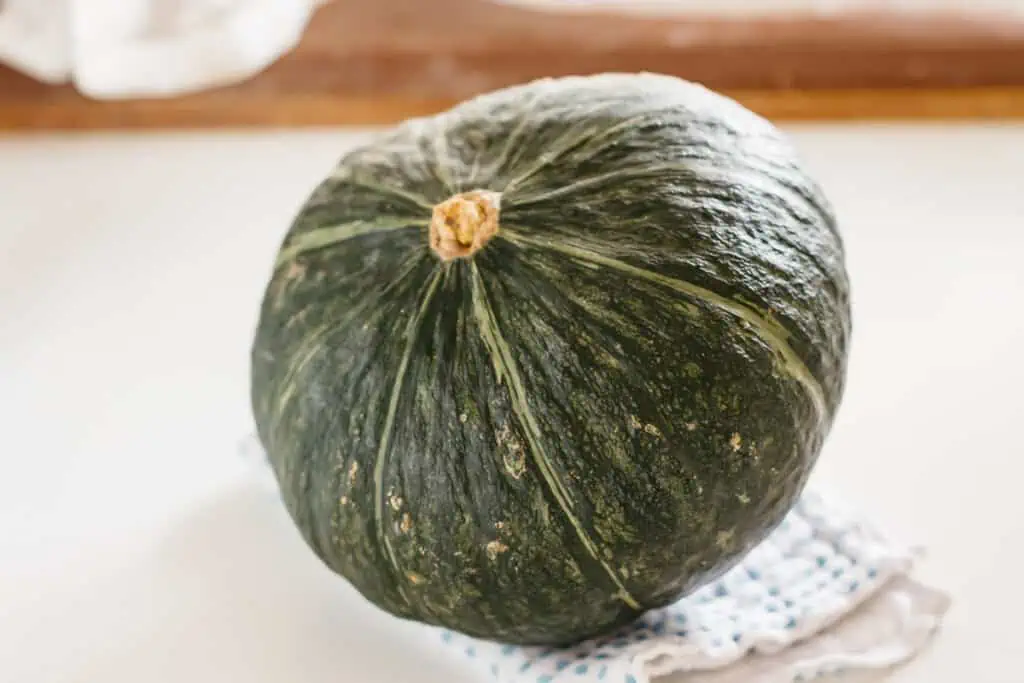
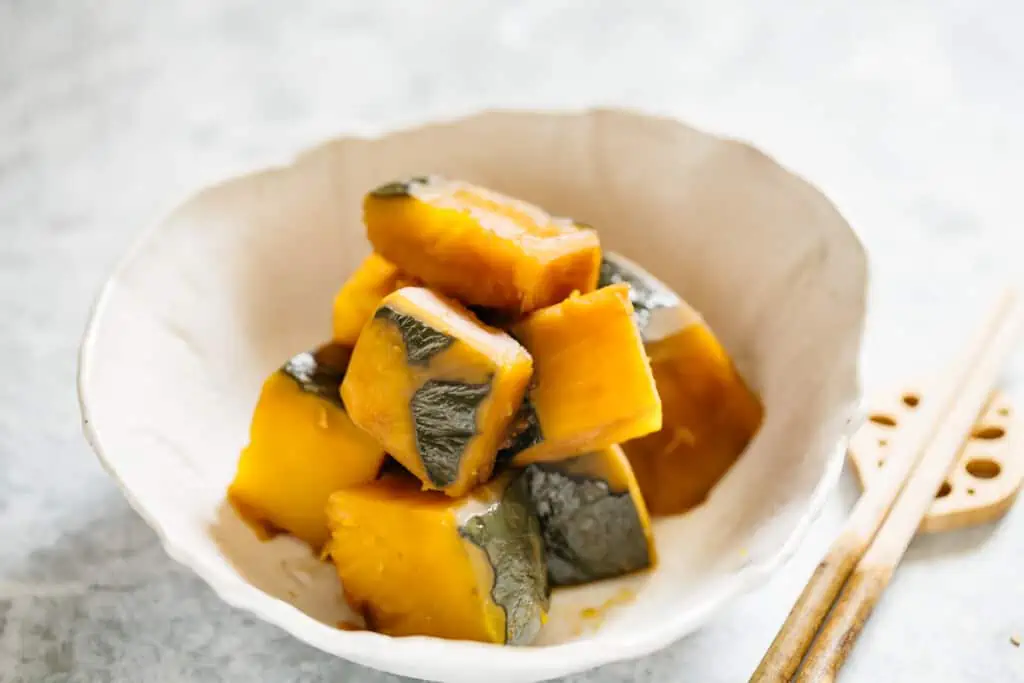
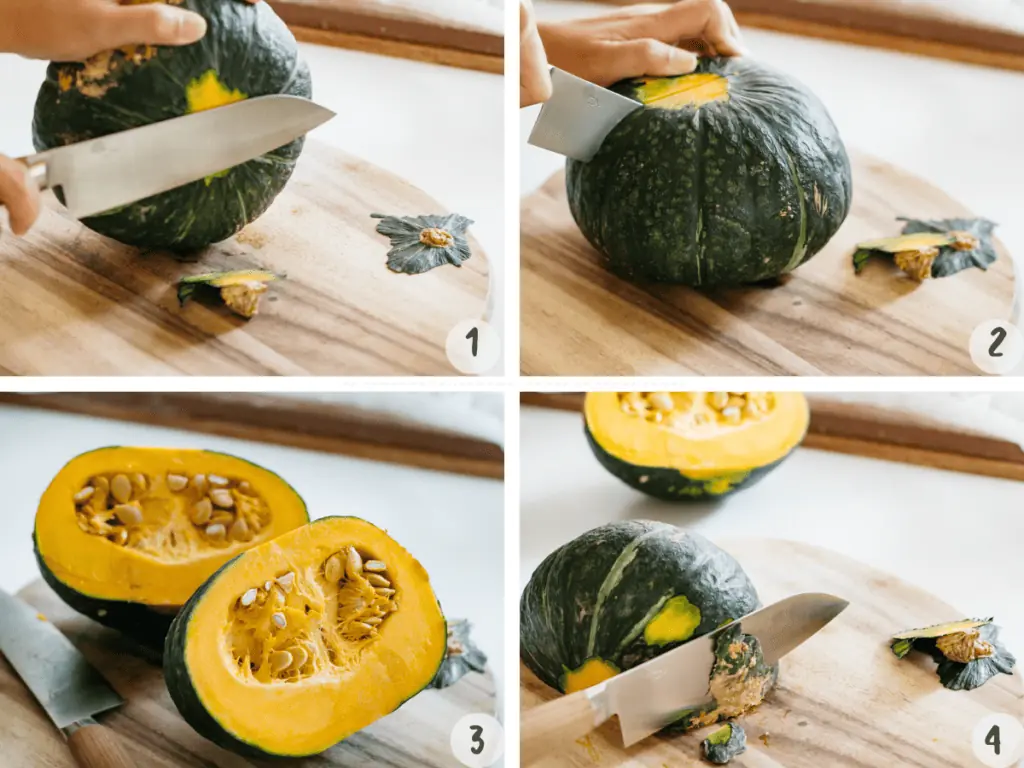
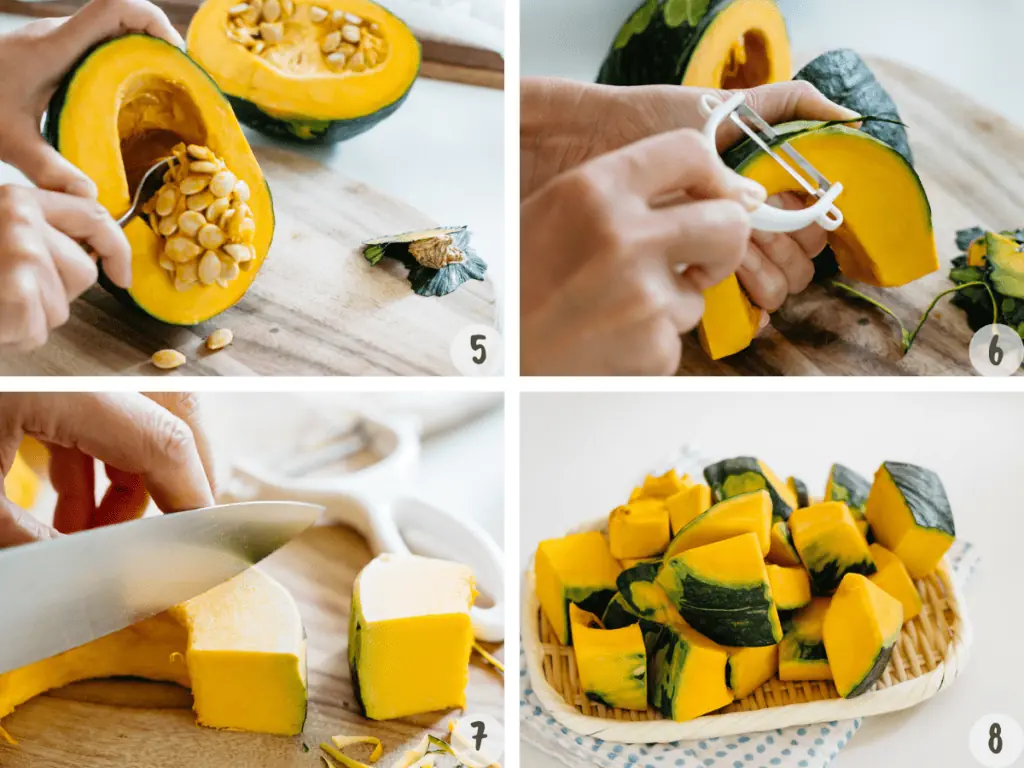
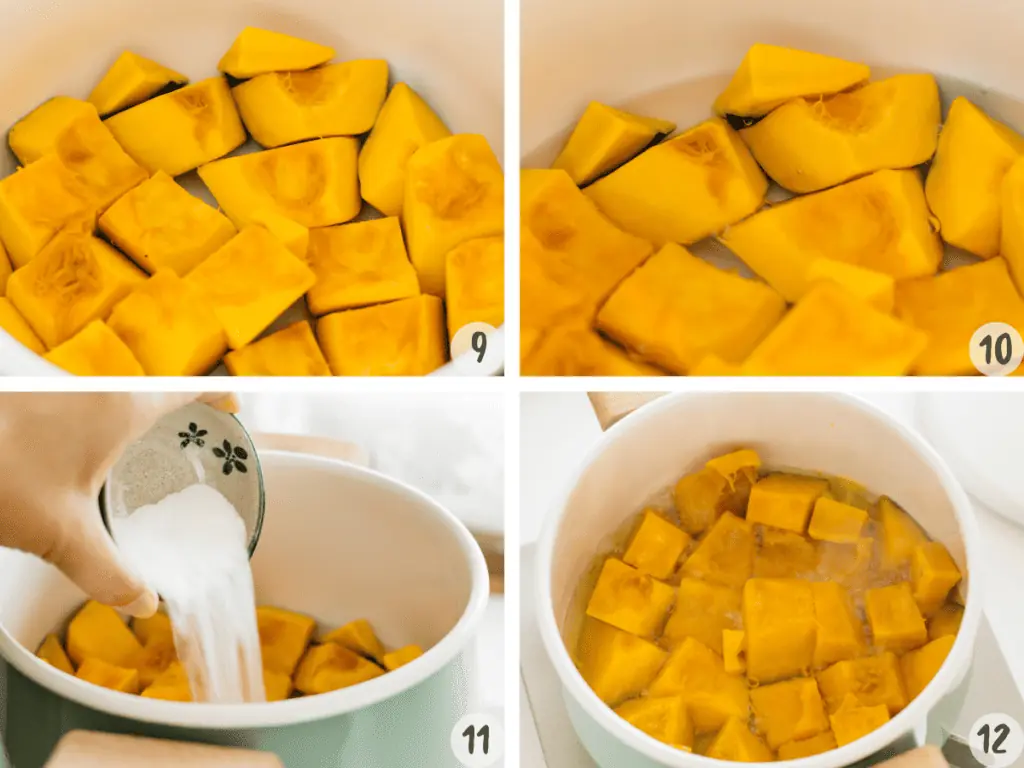
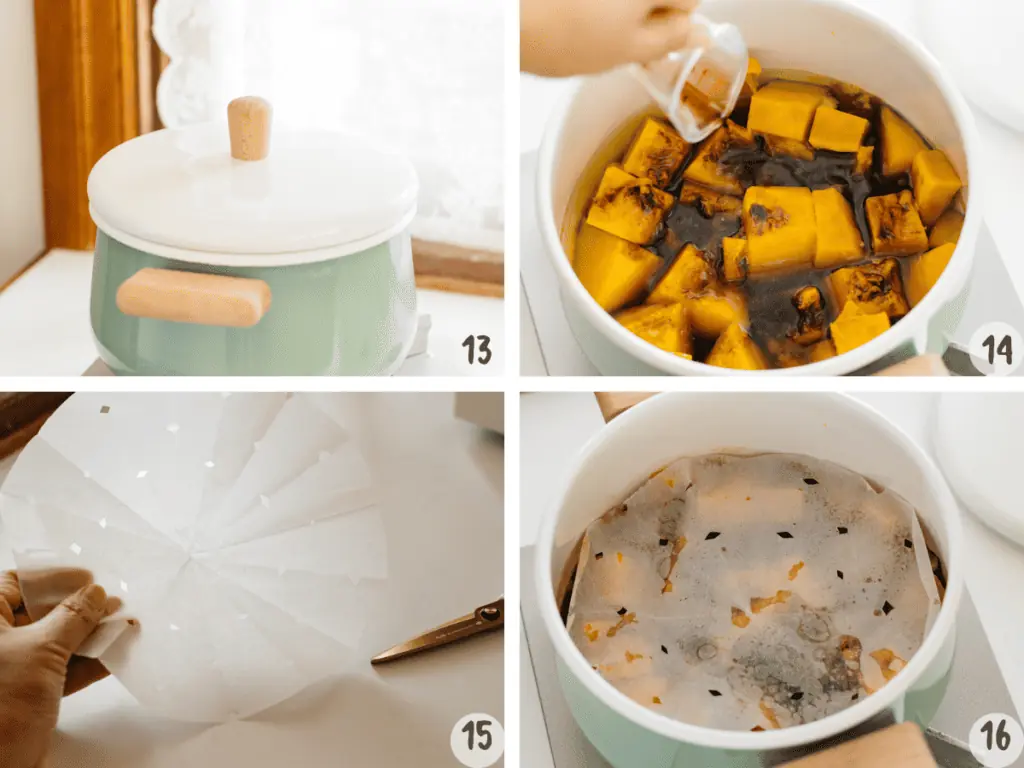
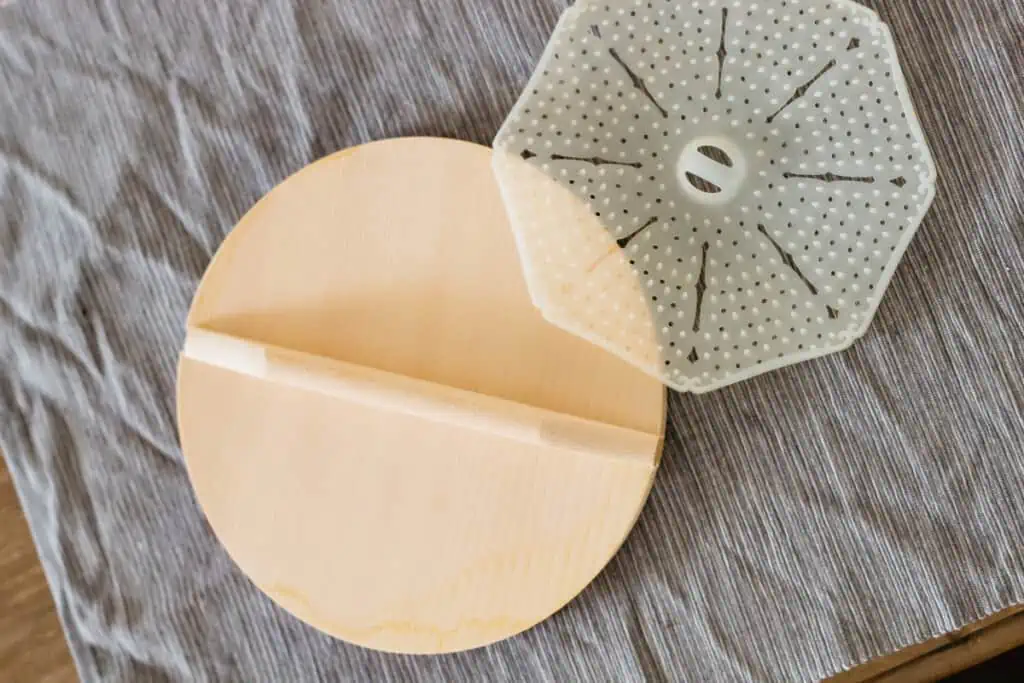
Hi, thanks so much for all your recipes – I am new to Japanese cooking.
One query – can I use Kombu Dashi for the simmering here? Your Kombu Dashi recipe says dashi should not be heated over 60 degrees or it will destroy the delicate flavour”?
many thanks
Hi Rachel yes you can 😀
Is this dish ever served cold? Thanks so much!
Hi nadia, yes you can serve it cold. I like it having cold in hot summer. I just had it a couple days ago.
This looks great. I’m not clear on the glaze – do I simmer it in a separate pot, or add all the ingredients to the squash as it cooks? Thanks!
Hi Alison, all ingredients in one pot 😀
Hi……I found this recipe and it’s exactly like the recipe my mother used to make before her passing. I have been making it since.
I was surprised because she used the same term when describing the texture….Hoku Hoku…funny.
By the way what part of Japan are you from……she was from Yamaguchi-ken
Oh thank you so much for your lovely comment. That is exactly I started this blog to share and pass on authentic Japanese recipe who lives outside of Japan and also to my children. I am glad that you found the recipe exactly the way your mom make and I am happy to hear your story. Thank you!! Happy new year. Oh and I am from Wakayama Prefecture.
Thank you for your receipt . I
Trying to find a recipe for the cabocha rice our one vegetarian cafe serves jn LA there is a lot of very tasty cabocha sauce so I
Trying to figure out how to cook that part maybe just blend some pieces of cooked cabocha ? I have a picture of that dish but don’t know how to post it here
I am craving it so bad! I went to farmers
Market and bought a cabocha and wood ear mash rooms for that dish now searching for the recipe
My local grocer always cuts it into small quarters for me if I ask. He’s got this giant, sharp knife that simplifies the cutting up. He also wraps it up in cling film, so I can store it in the fridge and use it when I need to.
Wow Lucky you Samantha!
Love this and love Kabocha…but I find it difficult to get. We are in Qld (Brisbane) also. Are you growing these or are you able to but them?
Hi Marilyn, I get this one at Fuji mart in Bandura shopping complex near Princess Alexandra Hp 😀
My LO would love this! I’m also trying to switch to a healthier lifestyle and started to mine for healthy recipes like yours. Also, I started and manage to get rid of some pounds. Your blog posts are super inspiring for me in this phase, thanks!
Thank you Mara. Hope your switching to healthier lifestyle will be successful with Japanese food.
I loved this recipe! I made the pumpkin to take for lunch in my bento box 😊
Hi Elli, That is fantastic! good idea to take for lunch 😀
Hi Shihoko,
I, too live in Brisbane ( north).
You could find this Kabocha pumpkin in The Global foods market at Woodbridge every Sunday.
Hi Tai!! Really!? OMG Thank you sooooo much for letting me know. I will be there next weekend! I am going to google where Woodbridge is 😀 Thank you!!!
Konichiwa Shihoku-san, my Aunt and grandmother always used to make this recipe with fatty pork chunks. They are unfortunately both passed and I can’t find a recipe uses it in there kabocha recipe. Wondering if you have run into one that does ?
Hi Niki-chan, thank you for reaching out to me 😀 Was it fatty pork chunks? I know one dish commonly made is with ground meat called “Soboro ankake”. I will keep researching 😀
Hi Niki-chan, I think the dish you’re looking for is called “Kakuni”, it’s a recipe that simmers/braises chunks of pork belly in a similar broth (with dashi, soy, sake, mirin, etc…). I hope that’s what you’re looking for.
But with Kabocha?
Hi Niki-chan and Shihoko,
I think the dish you are looking for is :
Simmered Kabocha Pumpkin Soboro.
Oishi! I’ve made this several times and it always turns out great. Cutting the squash is the hardest part!
Thanks!
Thank you Liz for trying this recipe and I am glad that it is “Oishii” 😀 Yes, cutting is hard but it is worth your effort isn’t it?
look delicious!
thank you!
Oh wow, I’ve always loved eating these at Japanese restaurants! I thought it was probably a simple recipe, but for some reason have never bothered to look it up. So thanks for sharing this! This will become a staple in my household, for sure.
PS: Your website and your photography are gorgeous! Such a pleasure to thumb through your recipes. 🙂
Hi Nina, Thank you so much for visiting my blog 😀 I am glad that you like it 😀